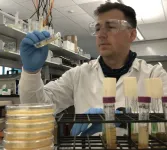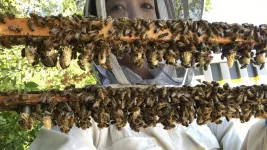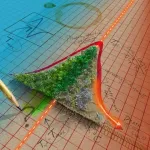(Press-News.org) The build-up of calcium in a major artery outside of the heart could predict future heart attack or stroke, a new Edith Cowan University led study has demonstrated.
Published today in the Journal of the American Heart Association, the research could help doctors identify people at risk of cardiovascular disease years before symptoms arise.
Analysing 52 previous studies, the international team of researchers found that people who have abdominal aortic calcification (AAC) have a two to four times higher risk of a future cardiovascular event.
The study also found the more extensive the calcium in the blood vessel wall, the greater the risk of future cardiovascular events and people with AAC and chronic kidney disease were at even greater risk than those from the general population with AAC.
Calcium can build up in the blood vessel wall and harden the arteries, blocking blood supply or causing plaque rupture, which is a leading cause of heart attacks and strokes.
The factors contributing to artery calcification include poor diet, a sedentary lifestyle, smoking and genetics.
Predicting a 'silent killer'
Lead researcher Associate Professor Josh Lewis from ECU's School of Medical and Health Sciences, and Heart Foundation Future Leader Fellow, said the findings offer important clues for cardiovascular health.
"Heart disease is often a silent killer as many people don't know they are at risk or that they have the early warning signs, such as abdominal or coronary artery calcification," he said.
"The abdominal aorta is one of the first sites where the build-up of calcium in the arteries can occur - even before the heart. If we pick this up early, we can intervene and implement lifestyle and medication changes to help stop the condition progressing."
Saving lives
Associate Professor Lewis hopes this discovery will lead to more people understanding their own risk of having a heart attack or stroke.
"Abdominal aortic calcification is often picked up incidentally in many routine tests, such as lateral spine scans from bone density machines or x-rays, and now we have a much better idea of the prognosis in these people when it is seen," he said.
"This can signal an early warning for doctors that they need to investigate and assess their patient's risk of heart attack or stroke.
"Ultimately, if we can identify this condition sooner, people can make lifestyle changes and start preventative treatments earlier, which could potentially save many lives in the future."
The international study involved researchers from INSERM, the Hinda and Marcus Institute for Ageing Research, University of Sydney, University of Western Australia and University of Minnesota.
The study builds on Associate Professor Lewis's recent research on using bone density scans and artificial intelligence to identify and quantify abdominal aortic calcification.
A promising future
Associate Professor Josh Lewis is supported in his position at ECU by the National Heart Foundation of Australia Future Leader Fellowship.
The Heart Foundation's manager of clinical evidence, Amanda Buttery welcomed the study.
"The researchers found that evidence of abdominal aortic calcification in patients with no known cardiovascular disease may indicate that a more comprehensive cardiovascular risk assessment is required, including blood pressure and cholesterol testing or a Heart Health Check," Ms Buttery said.
"The findings are promising, and the Heart Foundation would like to see more research in this area."
INFORMATION:
'Prognostic value of abdominal aortic calcification: A systematic review and meta-analysis of observational studies' was published in the Journal of the American Heart Association.
Decades of research show that depression, stress, loneliness, and poor health behaviors can weaken the body's immune system and lower the effectiveness of certain vaccines. A new report accepted for publication in Perspectives on Psychological Science suggests that the same may be true for the new COVID-19 vaccines that are in development and the early stages of global distribution. Fortunately, it may be possible to reduce these negative effects with simple steps like exercise and sleep.
Vaccines are among the safest and most effective advances in medical history, protecting society from a wide range of otherwise devastating diseases, including smallpox and polio. The key to their success, however, is ensuring that a critical percentage of the population is effectively ...
Pulsed ultraviolet light can be an effective alternative to some of the antimicrobial technologies now used by the poultry industry to kill pathogens on eggshells, according to Penn State researchers, who simulated production conditions to test the technology.
Researcher Paul Patterson, professor of poultry science, College of Agricultural Sciences, suggests the technology has merit for commercial application in the egg industry.
"This study is unique because it scaled-up and applied components of standard egg processing to a conveyor and sanitizing eggs in a commercial setting," he said. "In the absence of water or other chemical sanitizers, this technology ...
Honey bee health has been on the decline for two decades, with U.S. and Canadian beekeepers now losing about 25 to 40% of their colonies annually. And queen bees are failing faster than they have in the past in their ability to reproduce. The reason has been a mystery, but researchers at North Carolina State University and the University of British Columbia are finding answers.
Their latest research, published Jan. 8 in the journal Communications Biology, offers clues about what's behind queen bee failure, finding that when sperm viability is low, the expression of a protein known to act against pathogens such as bacteria and viruses is high.
David Tarpy, a University Faculty Scholar and professor in NC State's Department ...
BOSTON -- Completing cancer screening tests, such as mammograms, can be challenging for low-income people, who may face such challenges as lack of transportation or inability to take time off work. A team at Massachusetts General Hospital (MGH) explored the possibility of addressing preventive care needs when patients are admitted to the hospital.
The pilot study, published in the Annals of Family Medicine, examined the feasibility of performing mammograms in women insured by Medicaid or both Medicaid and Medicare (dual-eligible patients) while they were hospitalized. "We designed the study to reach the patients who face significant barriers to completing their mammograms in the outpatient setting," says Andrew S. Hwang, MD, MPH, an internist at MGH and first author of ...
DES PLAINES, IL -- Among children who were not in an independently verified incident, evaluation for child abuse should be done by specialty consultation in children aged less than three-years old presenting with rib fractures and children aged less than 18-months presenting with humeral or femoral fractures. That is the conclusion of a study titled Identifying Maltreatment in Infants and Young Children Presenting with Fractures: Does Age Matter?, to be published in the January 2021 issue of Yersinia pestis (AEM), a journal of the Society for Academic Emergency Medicine (SAEM).
The lead author of the study is Ian ...
Since the dawn of the 21st century, there has been a rapid rise in the number of human immunodeficiency virus (HIV) infections in China, and today, the epidemic continues to grow. Several populations are victims of this virus, including injection drug users, sex workers, and men who have sex with men (MSM). In the various decades since HIV has gripped China, these groups and others have variously been at the forefront or background of national efforts to tackle the epidemic.
In the recent past, the prevalence of HIV has been high among the MSM population, particularly, MSM students. According to China CDC's national data on newly reported ...
(Boston) -- Minimally invasive surgeries in which surgeons gain access to internal tissues through natural orifices or small external excisions are common practice in medicine. They are performed for problems as diverse as delivering stents through catheters, treating abdominal complications, and performing transnasal operations at the skull base in patients with neurological conditions.
The ends of devices for such surgeries are highly flexible (or "articulated") to enable the visualization and specific manipulation of the surgical site in the target tissue. In the case of energy-delivering devices that allow surgeons to cut or dry (desiccate) tissues, and stop internal bleeds (coagulate) deep inside the body, a heat-generating energy source is ...
Earth's ability to absorb nearly a third of human-caused carbon emissions through plants could be halved within the next two decades at the current rate of warming, according to a new study in Science Advances by researchers at Northern Arizona University, the Woodwell Climate Research Center and the University of Waikato, New Zealand. Using more than two decades of data from measurement towers in every major biome across the globe, the team identified a critical temperature tipping point beyond which plants' ability to capture and store atmospheric carbon--a cumulative effect referred to as the "land carbon sink"--decreases as temperatures continue to rise.
The terrestrial biosphere--the activity of land plants and soil microbes--does much of Earth's "breathing," exchanging ...
Researchers from MBARI, the University of Hawai'i at Mānoa (UH Mānoa), and Woods Hole Oceanographic Institution, after years of development and testing, have successfully demonstrated that a fleet of autonomous robots can track and study a moving microbial community in an open-ocean eddy. The results of this research effort were recently published in Science Robotics.
Autonomous robotic fleets enable researchers to observe complex systems in ways that are otherwise impossible with purely ship-based or remote sensing techniques. In a time when the COVID-19 ...
Rising temperatures could trigger Earth's terrestrial ecosystems to transition from carbon sinks to carbon sources in the next 20 to 30 years, according to data from the world's largest continuous carbon monitoring network. The researchers suggest that up to half of land ecosystems could reach this tipping point - when plants begin to release carbon into the atmosphere faster than they sequester it - by 2100 under a business-as-usual emissions scenario. However, biomes that store the most carbon, including rainforests and Taiga forests, may lose more than 45% of their ...





